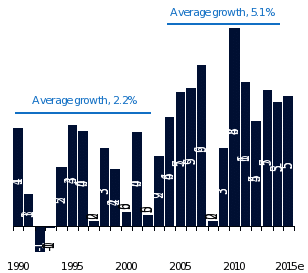Economic Commentary
Kenya is now the third largest economy in Sub-Saharan Africa (SSA) after Nigeria and South Africa with nominal GDP of USD66bn expected in 2015. The economy is dependent on agriculture, which accounts for ~30% of GDP and ~40% of exports (Kenya is the world’s leading exporter of black tea). Real GDP growth is currently relatively high, expected to be 5.5% in 2015 driven by investment in infrastructure and high population growth.
Kenya’s long-term fundamentals are underpinned by positive demographics. The 44m population is growing quickly (2.7% a year) and urbanising, leading to rising wealth, an expanding middle class, strong growth in the supply of labour and rapidly growing demand for consumer services. Kenya is also expected to start producing and exporting oil from 2021, which would provide a further impetus to growth. However, in the short term Kenya’s weak fiscal and external positions leave it exposed to the risk of capital flight.
From 1990 to 2003, Kenya’s real GDP growth was weak, averaging 2.2% as a result of protectionist policies, economic mismanagement, patchy reforms and corruption. However, after Kenya’s first truly free and fair elections in 2002, the economy turned around as a number of reforms were implemented, including deregulation, anti-corruption laws and an overhaul of the public finances, leading to an improved business environment. As a result, private and public investment rose sharply, including from foreign investors (foreign direct investment rose from USD21m in 2005 to USD514m in 2013), and GDP growth picked up to an estimated average of 5.1% in 2004-14. In 2014, Kenya issued a USD2bn sovereign bond (SSA’s largest ever debt issue), which was four times oversubscribed.
To further encourage investment and develop the economy, a number of major projects are being implemented, including the Mombasa-Nairobi railway, geothermal plants, irrigation projects, and new oil pipelines. These projects should help ease bottlenecks in the transport and energy sectors and should support more stable growth in agriculture. As a result, the economy is expected to grow by around 5.5% in 2015, supported by fiscal stimulus, rising infrastructure investment and strong private consumption growth.
Real GDP Growth
(%, average growth indicated)

Sources: IMF and QNB Economics
However, Kenya is exposed to risks of capital flight. The current account deficit is expected to be 7.7% of GDP in 2015 and international reserves are low (around four months of import cover). Meanwhile, the fiscal deficit is expected to be 7.6% of GDP in 2015 and public debt is high and rising (50.0% of GDP in 2015 compared with 48.6% in 2014). The twin deficits arepart financed by capital from abroad, exposing Kenya to a “sudden stop” in inflows. The Kenyan authorities have already requested a precautionary facility with the IMF for USD688m in case of a balance of payments shock and may need to tap that facility this year.
A number of factors are dragging on growth and could trigger a reversal in sentiment and capital flows. First, dry weather is leading to poor harvests, holding back growth in agriculture. Second, external pressures have already led to a sharp depreciation in the Kenyan shilling (down 19% in the year to 14th September 2015) and weaker capital inflows, which could intensify if the US Federal Reserve starts hiking interest rates later this year as expected. Third, the Central Bank of Kenya raised interest rates twice in June and July, by 300 basis points in total, to 11.5% to combat the weakening exchange rate and high inflation (6.4% on average so far this year). Fourth, a deterioration in the security situation has badly hit tourist visitor numbers (down 19% in the first half of 2015 compared to last year).
In summary, Kenya has a lot of positives: strong investment, high population growth, and a backstop of USD1bn to USD2bn of additional oil revenue expected to come online in 2021. As a result, many forecasters expect growth of over 6% over the long term. However, in the meantime there is a real risk of a balance of payments crisis that could seriously upset growth in the short term.
Disclaimer: QNB Group accepts no liability whatsoever for any direct or indirect losses arising from use of this report. Where an opinion is expressed, unless otherwise provided, it is that of the analyst or author only. Any investment decision should depend on the individual circumstances of the investor and be based on specifically engaged investment advice. The report is distributed on a complimentary basis. It may not be reproduced in whole or in part without permission from QNB Group.

